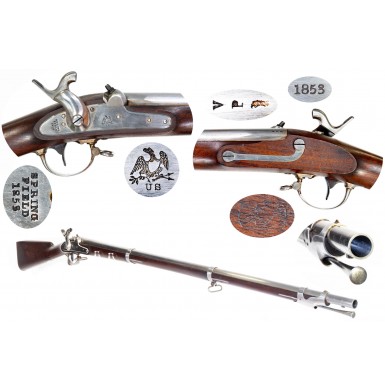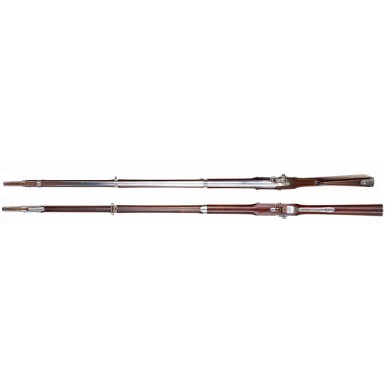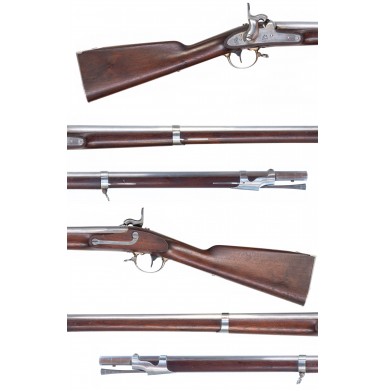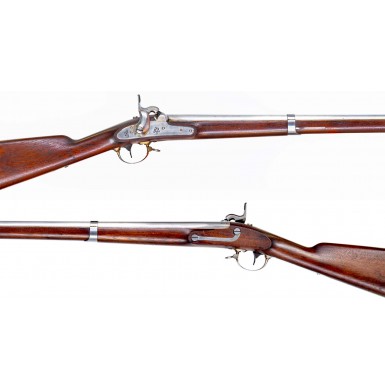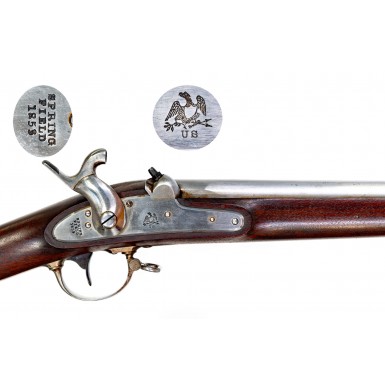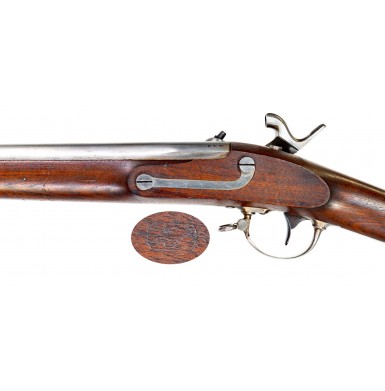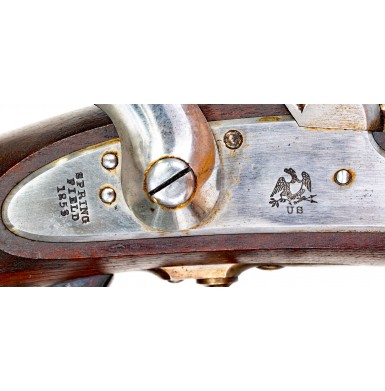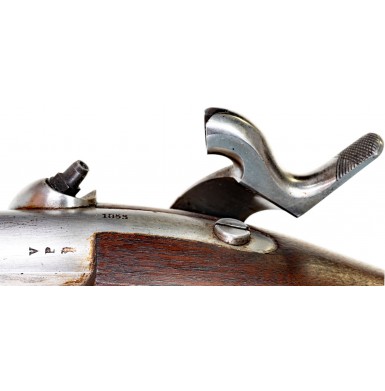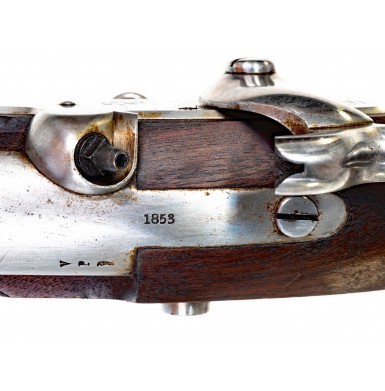Excellent US Model 1842 Musket by Springfield
- Product Code: FLA-B139-SOLD
- Availability: Out Of Stock
-
$5,900.00
The US Model 1842 Percussion Infantry Musket represented a major advancement in the production of US military small arms during the mid-19th century. The Model 1842 was the first general issue US military long arm to utilize the percussion ignition system and was also the first general issue arm to be manufactured on the principle of fully interchangeable parts at both US arsenals. While the percussion ignition system had been introduced to the US military with the M1833 Hall-North Carbine on a very limited basis, and a few years later with the Model 1841 “Mississippi” Rifle, these arms were not widely issued and were reserved for specialty troops and state militia use. Likewise, the Harpers Ferry produced Model 1819 Hall Rifle had been manufactured on the interchangeable parts principle since its introduction, but it was also a long gun that would see limited issuance and use, when compared to the infantry musket. The Model 1842 also had the distinction of the being the last general issue .69 caliber smoothbore weapon to be manufactured and issued to the US military and was superseded by the .58 caliber Model 1855 rifle musket slightly more than a decade after the Model 1842 was adopted.
The design that would become the US Model 1842 musket was initiated at the end of 1841, when the Chief of Ordnance requested that sample arms be forwarded for to the Ordnance Board for approval. The specification was simply that the current Model 1840 (sometimes referred to as the Model 1835/40) flintlock musket be redesigned as a percussion ignition weapon, with as few changes as possible. The goal was to make the transition to production of the new percussion musket as simply and quickly as possible. As such, the new Model 1842 was nearly identical to the preceding Model 1840, with the primary differences being in the use of the percussion rather flint lock system, and the incorporation of a percussion bolster, rather than a flint vent hole at the breech. The new Model 1842 retained the same 42-inch long, round smoothbore, muzzleloading barrel that was nominally .69 caliber. The barrel was retained by three flat, spring retained barrel bands, with the upper band being double strapped. All of the furniture was iron and polished bright, and the full-length musket stock was of American black walnut with the traditional flat, “shotgun” buttplate profile that would not be abandoned for US muskets until the adoption of the rifle musket. The US Model 1842 percussion musket went into production at the Springfield Arsenal in 1844; with 2,956 completed guns being delivered into stores that fiscal year (July 1, 1843-June 30, 1844). Production did not commence at Harper’s Ferry until 1845, and that armory delivered 2,225 arms into store during fiscal year 1845 (July 1, 1844-June 30, 1845). Even though completed muskets were not delivered into the storekeepers’ inventory until the dates noted above, the manufacture of parts commenced prior to delivery of completed arms; in some cases, as much as year prior to any deliveries. The locks and barrels of the guns were also dated based upon the annual calendar (January 1 – December 31) rather than the fiscal accounting calendar that ran from July 1 to June 30 of the next year. Thus, a gun completed in the second half of calendar year 1844 (after July 1 of 1844) would show up as “delivered” in 1845, as fiscal year 1845 began on July 1 of 1844, but would be dated 1844 on the parts. The Model 1842 musket remained in production until 1855, with Springfield Armory producing some 165,970 of the muskets and Harpers Ferry producing 106,629. This makes the total production for the Model 1842 musket 272,599 at the two National Armories. There were no official contractor produced Model 1842 Muskets for the US military, although contractor produced copies were produced for sale on the commercial market. These guns were primarily for state contracts and were produced by Benjamin Flagg, Asa Waters and William Glaze, primarily for sale to South Carolina.
The US Model 1842 musket saw significant use during the American Civil War, and as late at the summer of 1864 a significant number (at least 25,000) were still in the field with US forces. A similar (or possibly large number) were almost certainly still in service with the Confederacy as well. The fact that the US Model 1842 remained in service with the US government well into the war is underscored by the fact that Ordnance Department was forced to make inquiries with contractors to provide spare parts, including ramrods and bayonets for the guns, during 1864. As late as the 2ndquarter of 1864, the Ordnance Department was still attempting to obtain the necessary parts to keep the Model 1842 muskets that were in the field in serviceable condition. The ever-frugal US government kept thousands of US Model 1842 muskets in government stores until 1870, when they began to sell off the arms via auction to the highest bidder.
This US Model 1842 Percussion Musket by Springfield is in about EXCELLENT condition and remains extremely crisps and sharp throughout. The US arsenal at Springfield manufactured the musket and it was delivered during the latter part of fiscal year 1853 or the first half of fiscal year 1854. The gun bears the date 1853 on the lock and on the barrel’s breech plug tang. In fiscal-year 1853 some 14,500 US Model 1842 muskets were delivered into store at Springfield Arsenal, with an additional 10,000 delivered into store the following fiscal year. The musket is clearly and crisply marked in three vertical lines behind the hammer,
SPRING
FIELD
1853
with the usual {AMERICAN EAGLE} / US marked on the lock, forward of the hammer. The locks of the muskets were polished bright at the armories, with the exception of some very early guns circa 1844-45 that retained case coloring on the locks and retains much of that arsenal bright appearance. All of the markings are crisp and sharp, and the lock shows only some very minor discoloration that appears to be some old, dried oil, and some minor dulling due to age. The lock is mechanically EXCELLENT, and it functions perfectly on all positions. The breech of the musket is crisply marked with the usual V / P / {Eagle Head} proof and inspection marks, and the barrel tang is crisply stamped with the matching date1853. The barrel of the musket retains the appearance of its original National Armory Bright polished finish as well but was lightly cleaned long ago to return the gun to this brilliant appearance. The barrel is completely smooth and essentially free of any pitting with only some very extremely small traces of pinpricking present, primarily around muzzle of the musket. There are some small areas of minor dulling and discoloration scattered along the barrel, and a few tiny impact marks on the metal here and there. There are some tiny freckles of surface oxidation scattered here and there and the old remnants of the same brown discolored oil that is found in the recesses of the lock are seen in the protected areas of the barrel as well. The iron furniture retains the same generally bright appearance as the barrel and the lock, again showing only the most minor dulling from age. The barrel band springs do show some minor oxidation and age discoloration. The trigger retains most of its original blued finish from the heat drawing process but has dulled substantially with age. The bore of the musket is quite brilliant and very smooth, and rates about VERY FINE to NEAR EXCELLENT overall. The bore shows some scattered oxidation and some very minor pinpricking but is free of any real pitting and is truly fine. The tang of the buttplate is marked with usual US, which is crisply and deeply struck. The musket retains both of the original sling swivels, as well as its original trumpet head ramrod. The ramrod is full-length and has complete threads on the end. The original brass blade front sight is in place on the forward strap of the upper barrel band as well, and the original socket bayonet stud is in place under the barrel near the muzzle. The stock of the musket is in wonderful condition as well and rates about EXCELLENT as well. The stock is extremely crisp and retains sharp edges and lines throughout. The stock is full-length and solid with no breaks, cracks or repairs noted. The stock only shows a handful of minor bumps, mars and dings from use, handling, and storage, but absolutely no abuse of any kind. In fact, the stock is really in stunning condition for a 170-year-old military musket. The wood to metal fit is very nice throughout and shows the expected quality workmanship of Springfield Arsenal. The stock flat, opposite the lock, is crisply and deeply marked with a single script cartouche. These are the initials JS, the mark of Springfield Armory sub-inspector James Stillman, who worked at the arsenal from 1835 to 1891, the longest serving employee of the arsenal. During most of his tenure at the arsenal he the foreman of the stocking department, a position that he held for some fifty years. He also inspected arms from time to time over about a twelve-year period, with most of his inspections made between 1847 and 1860, at which time he inspected US Model 1842 Muskets, Model 1847 Musketoons, Model 1851 Cadet Muskets and Model 1855 rifle muskets and pistol carbines. Interestingly his cartouches are usually found alone and without the mark of Erskine Allin who served as the Master Armorer during most of the period that Stillman doubled as an arms inspector. This suggests that Stillman may have performed these duties when Allin was unavailable.
Overall, this is a really outstanding example of a US Model 1842 Musket from the famous Springfield Armory. The gun remains extremely crisp and sharp throughout outstanding markings in both the metal and the wood. It is really amazing that a 170-year-old military musket has survived in this fabulous condition. For any serious collector of US martial long arms, the Model 1842 is an essential gun. It was the first interchangeable parts US infantry musket, the first percussion US infantry musket, and the last of the large-bore, smoothbore US infantry muskets. Due to the outbreak of the American Civil War, these historic arms had a service life well after the time that they were rendered obsolete by rifle muskets. As such, they are an important part of any Civil War longarms collection, as well as an indispensable part of the history of the development of US infantry longarms.

